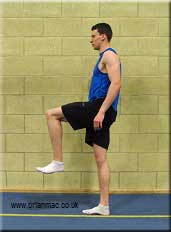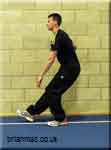

Klatt Test
Testing and measurement collect information on which subsequent performance evaluations and decisions are made. Performance evaluations and decisions are made. In the analysis, we need to consider the factors influencing the results.
Objective
The objective of the Klatt tests (1988) is to assess an athlete's balance, stability and jumping as a prerequisite to undertaking a plyometrics program.
Required Resources
To conduct this test, you will require:
- Gym.
- An assistant.
How to conduct the test
Balance and Stability
These tests are performed on bare feet (shoes and socks off).
|
 |
|
 |
Jump Tests
These tests should be performed wearing trainers.
|
 |
|
 |
Analysis
Distances achieved with the bunny hop and the two single-leg hops should be similar, squat depth similar and held for 10 seconds with minimal deviation and shaking.
On the single-leg hops, the hips must remain stable on landing - if not then single-leg plyometric work should be avoided until hip stability can be maintained.
Target Group
This test is suitable for pubescent male and female athletes.
Reliability
Test reliability refers to how a test is consistent and stable in measuring its intended measure. Reliability will depend upon how strictly the test is conducted and the individual's level of motivation to perform the test. The following link provides various factors influencing the results and test reliability.
Validity
Test validity refers to the degree to which the test measures what it claims to measure and the extent to which inferences, conclusions, and decisions based on test scores are appropriate and meaningful. This test provides a means to monitor the effect of training on the athlete's physical development.
Advantages
- Minimal equipment required
- Simple to set up and conduct
Disadvantages
- Specific facilities required
- Assistant required to administer the test
Page Reference
If you quote information from this page in your work, then the reference for this page is:
- MACKENZIE, B. (2004) Klatt Tests [WWW] Available from: https://www.brianmac.co.uk/lastest.htm [Accessed